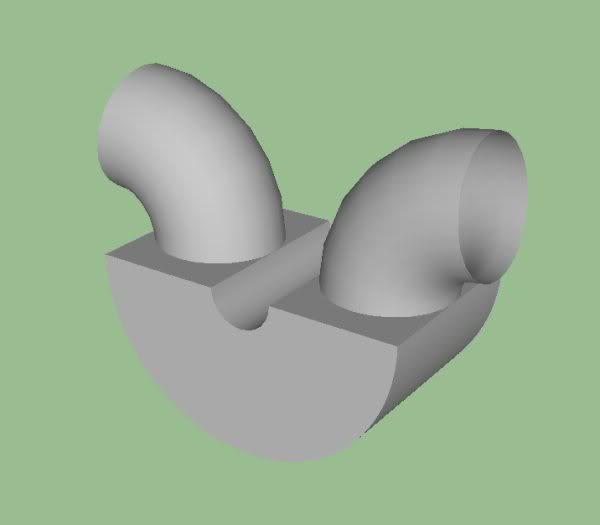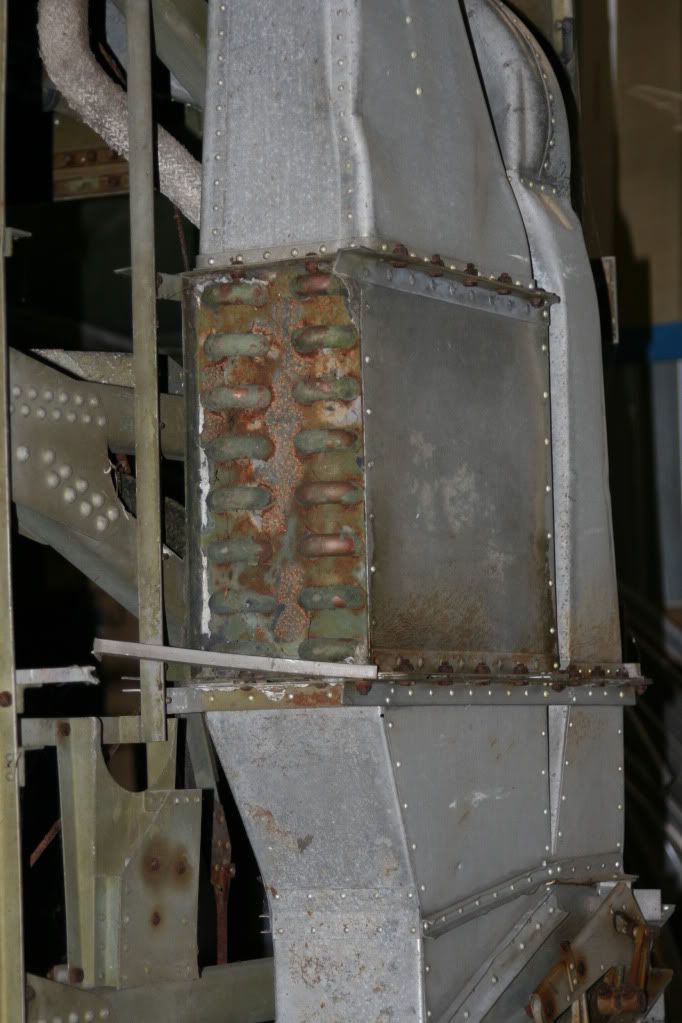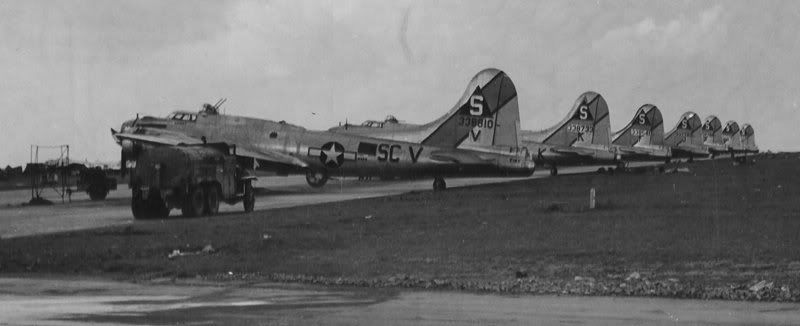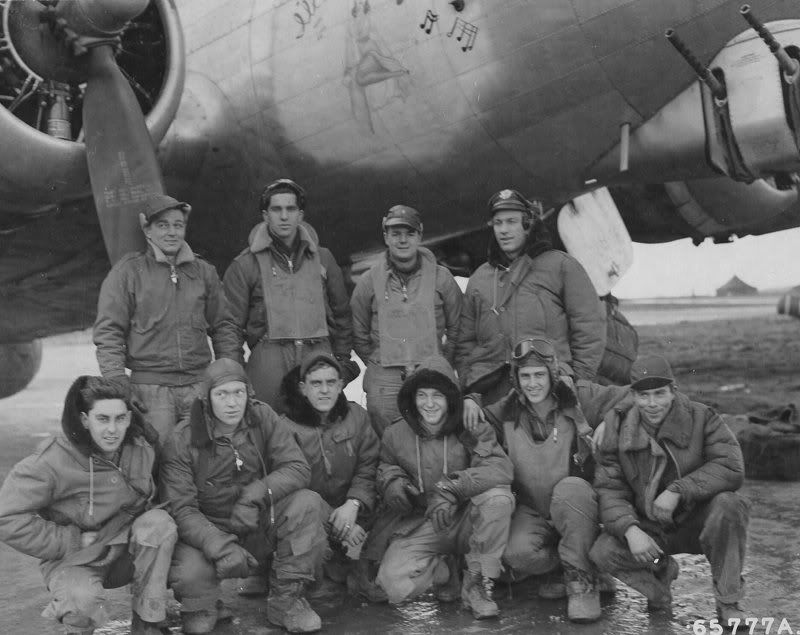Tue Oct 20, 2009 6:12 pm
RAMC181 wrote:Would anyone have a photo or drawing of a B-17 intercooler?
I'd like to make sure the ones we found are actually what we think they are.
Thanks in advance,
Paul
P-38Js onward had an intercooler below the engine as well. Ducting was side by side on top covering the entire top and was attached by a ton of AN3 bolts.
Rich
Tue Oct 20, 2009 6:26 pm
Thanks for that Bill, much appreciated.
So, what we have aren't B-17 intercoolers then.
Here's a very poor sketch of what we have, some have casings around the lower (finned) section, some don't.

All the best,
Paul
So, what we have aren't B-17 intercoolers then.
Here's a very poor sketch of what we have, some have casings around the lower (finned) section, some don't.

All the best,
Paul
Tue Oct 20, 2009 6:35 pm
If I recall, the B-17 does have some duct work like that. I remember staring at it in Texas Raiders during one of my inspections on it. I just can't recall if it was for the intercooler, air filter, or oil cooler. 
Gary
Gary
Tue Oct 20, 2009 7:41 pm
Holedigger wrote: I wonder about bases here in the States? Was the protocol for discarded bits organized and efficient in scrapping and getting the usable metals back to the factories to make more AC, or was there a bunch of this,"Just bury it in a hole and forget about it" mentality going on....?
In '61 or'62 that "bury it" mentality still existed at Kincheloe AFB's satellite, Raco missile site. I was one guy in a three man detail sent to dispose of unwanted (by the USAF) items in a large hole in the sandy ground that was so prevalent around Raco.
Wed Oct 21, 2009 12:38 am
RAMC181 wrote:Thanks for that Bill, much appreciated.
So, what we have aren't B-17 intercoolers then.
Here's a very poor sketch of what we have, some have casings around the lower (finned) section, some don't.
All the best,
Paul
Paul,
What diameter are the two tubes on that piece? I'm wondering if they could be part of the early style cockpit heating equipment.
I don't recall seeing anything exactly like that in Chuckie, and she still has turbos and intercoolers installed, nor do I recall seeing anything like it in TR.
Scott
Heat Exchanger
Wed Oct 21, 2009 7:04 am
This is an early style fuselage heat exchanger. Looks nothing
like Paul's drawing.

Wed Oct 21, 2009 8:23 am
Well dang. Maybe I'm wrong on seeing something like that on TR. Hmmm. I could've sworn I remember a big "U" shaped piece of ducting in the wings, but maybe I was just dreamin'. 
Gary
Gary
Wed Oct 21, 2009 9:08 am
Thanks, Bill. I don't have a parts catalog up here so gave a wild guess. And thanks for the photo of the early heater system. Our airplane has the later style and we probably have enough parts in the warehouse to make it function if one wanted to.
As far as that component, I'm still stumped too.
Gary, TR still has some of the heater ductwork in the wings and I'll bet that is what you're thinking of.
Scott
As far as that component, I'm still stumped too.
Gary, TR still has some of the heater ductwork in the wings and I'll bet that is what you're thinking of.
Scott
Wed Oct 21, 2009 9:55 am
I would imagine, even then, that live ordanace disposal was handeled quite differently than burying in just a trench!
Wed Oct 21, 2009 12:27 pm
ktst97 wrote:Holedigger wrote: I wonder about bases here in the States? Was the protocol for discarded bits organized and efficient in scrapping and getting the usable metals back to the factories to make more AC, or was there a bunch of this,"Just bury it in a hole and forget about it" mentality going on....?
In '61 or'62 that "bury it" mentality still existed at Kincheloe AFB's satellite, Raco missile site. I was one guy in a three man detail sent to dispose of unwanted (by the USAF) items in a large hole in the sandy ground that was so prevalent around Raco.
So what did you put in the hole?
Wed Oct 21, 2009 1:40 pm
I passed the info along to my wife who works at Discovery. Who knows.....
retroaviation wrote:Wow...with a capital "W"!!!!! That's a heck of a cool find there.
Two questions though...
1. Even though I'm sure they talk funny on that BBC special they're filming, which'll make it hard to understand, I wonder if anyone here in the States, such as the History Channel, Discovery, etc., will air it over here? Maybe they can use subtitles.
Gary
Wed Oct 21, 2009 3:21 pm
Retroaviation (Gary)
The pipe work for the air system on TR was all reworked on the 1983-1986 restoration. If I remember right some of the duct work does look like the picture, and I think at this time we removed the intercoolers.
Jimmy in Texas
The pipe work for the air system on TR was all reworked on the 1983-1986 restoration. If I remember right some of the duct work does look like the picture, and I think at this time we removed the intercoolers.
Jimmy in Texas
Wed Oct 21, 2009 3:30 pm
Second Air Force wrote:Paul,
What diameter are the two tubes on that piece? I'm wondering if they could be part of the early style cockpit heating equipment.
I don't recall seeing anything exactly like that in Chuckie, and she still has turbos and intercoolers installed, nor do I recall seeing anything like it in TR.
Scott
Scott,
IIRC the tubes were about 4" dia., stainless steel.
Of those that still had casings around the finned C-section, the casing was green enamelled steel on the outside, black enamelled on the inside. (The same as the exhaust heatshields in the engine accessory section of the nacelles.)
Heavy lumps too, you wouldn't want to carry one too far on your own.
All the best,
Paul
Fri Oct 23, 2009 8:13 am
One of the stencilled panels recovered:

This is marked to B-17G-95-BO 43-38733, SC-K "I'll Be Seeing You" of the 612th Bomb Squadron, 401st Bomb Group.
'733 can be seen in the line-up below, second from the front.

On March 24th 1945, while bombing a Luftwaffe airfield in support of the Operation Varsity Rhine crossings, the 36 B-17s put up by the 401st encountered "deadly accurate" flak over the target.
18 of the 36 were damaged, 16 of receiving major damage.
One of these heavily damaged aircraft was SC-K, being flown by Lt C.J. Campbell and his crew, who were on their 29th mission.
Despite losing two engines over the target and having the elevator controls shot away, making the aircraft nearly uncontrollable, Lt. Campbell managed to nurse his plane back across the Channel to England.
Spotting Halesworth airfield near the coast, Lt. Campbell let down to land, but on final approach a third engine failed, which threw the plane into a spin and resulted in a crash just short of the runway.
Campbell and his Co-pilot Lt. P.W. Foy miraculously survived, but the remaining seven members of the crew perished in the crash:
Navigator:
Lt D.B. Gruhn
Togglier:
S/Sgt Joseph R. Pearlin, #11120564
Air Medal with 3 Oak Leaf Clusters and Purple Heart.
Buried in Plot C, Row 1, Grave 51, Cambridge American Cemetery, England.
Radio Operator:
T/Sgt G.M. Feo
Engineer / Top Turret Gunner:
T/Sgt C.F. Kartes
Ball Turret Gunner:
S/Sgt E. Sullivan
Tail Gunner:
S/Sgt C.K. Dalton
Waist Gunner:
S/Sgt H.M. Murray
Campbell and his crew in front of '733 on February 10th 1945, after returning from a mission to Dulmen, Germany:

Lest we forget

This is marked to B-17G-95-BO 43-38733, SC-K "I'll Be Seeing You" of the 612th Bomb Squadron, 401st Bomb Group.
'733 can be seen in the line-up below, second from the front.

On March 24th 1945, while bombing a Luftwaffe airfield in support of the Operation Varsity Rhine crossings, the 36 B-17s put up by the 401st encountered "deadly accurate" flak over the target.
18 of the 36 were damaged, 16 of receiving major damage.
One of these heavily damaged aircraft was SC-K, being flown by Lt C.J. Campbell and his crew, who were on their 29th mission.
Despite losing two engines over the target and having the elevator controls shot away, making the aircraft nearly uncontrollable, Lt. Campbell managed to nurse his plane back across the Channel to England.
Spotting Halesworth airfield near the coast, Lt. Campbell let down to land, but on final approach a third engine failed, which threw the plane into a spin and resulted in a crash just short of the runway.
Campbell and his Co-pilot Lt. P.W. Foy miraculously survived, but the remaining seven members of the crew perished in the crash:
Navigator:
Lt D.B. Gruhn
Togglier:
S/Sgt Joseph R. Pearlin, #11120564
Air Medal with 3 Oak Leaf Clusters and Purple Heart.
Buried in Plot C, Row 1, Grave 51, Cambridge American Cemetery, England.
Radio Operator:
T/Sgt G.M. Feo
Engineer / Top Turret Gunner:
T/Sgt C.F. Kartes
Ball Turret Gunner:
S/Sgt E. Sullivan
Tail Gunner:
S/Sgt C.K. Dalton
Waist Gunner:
S/Sgt H.M. Murray
Campbell and his crew in front of '733 on February 10th 1945, after returning from a mission to Dulmen, Germany:

Lest we forget
Fri Oct 23, 2009 8:48 am
RAMC181 wrote:Second Air Force wrote:Paul,
Scott,
IIRC the tubes were about 4" dia., stainless steel.
Of those that still had casings around the finned C-section, the casing was green enamelled steel on the outside, black enamelled on the inside. (The same as the exhaust heatshields in the engine accessory section of the nacelles.)
Heavy lumps too, you wouldn't want to carry one too far on your own.
All the best,
Paul
I'll do some research on that component this weekend, Paul. We're going to be working on Chuckie and I'll see what I can find in the airplane and our parts storage area.
Scott